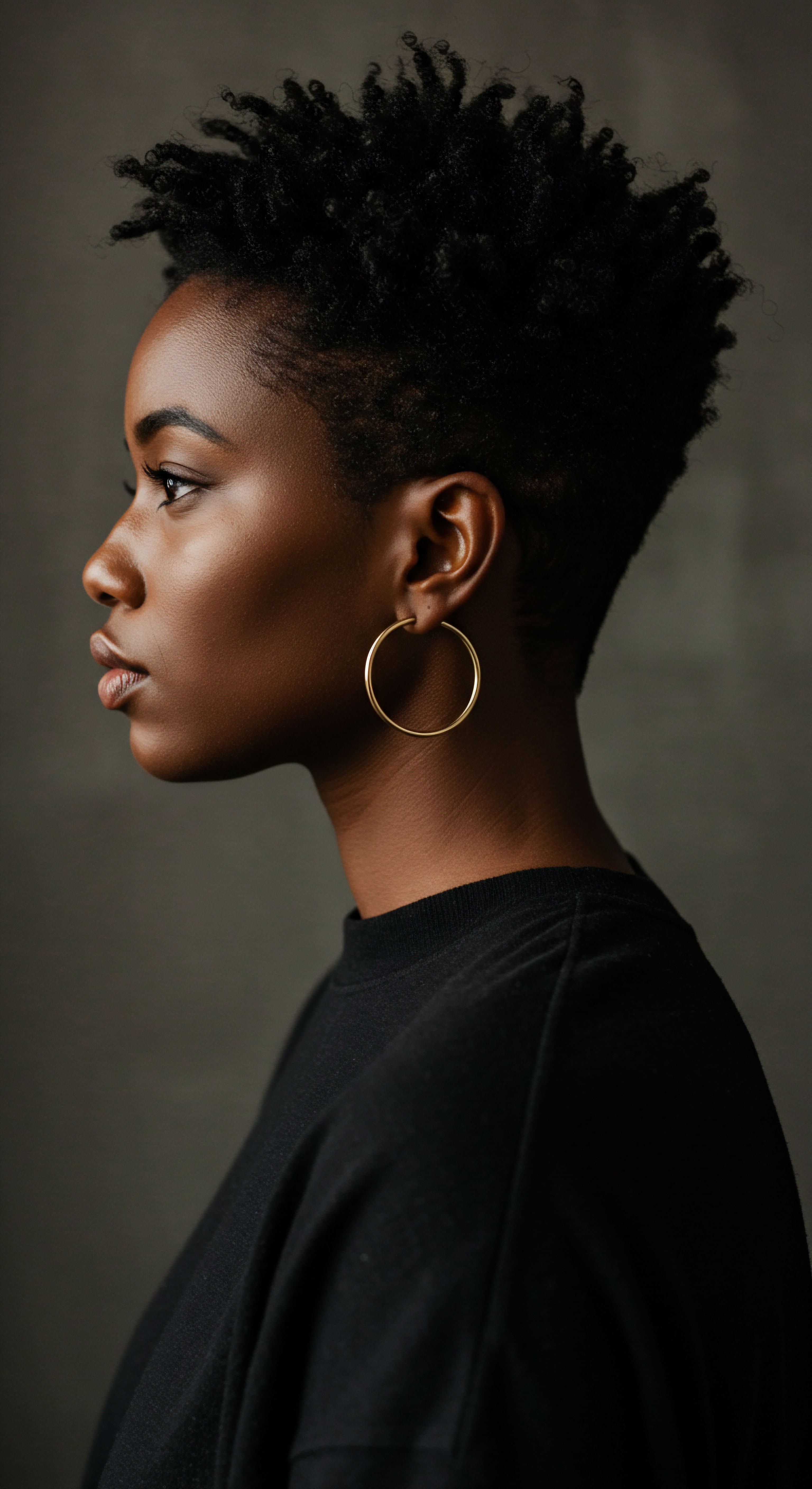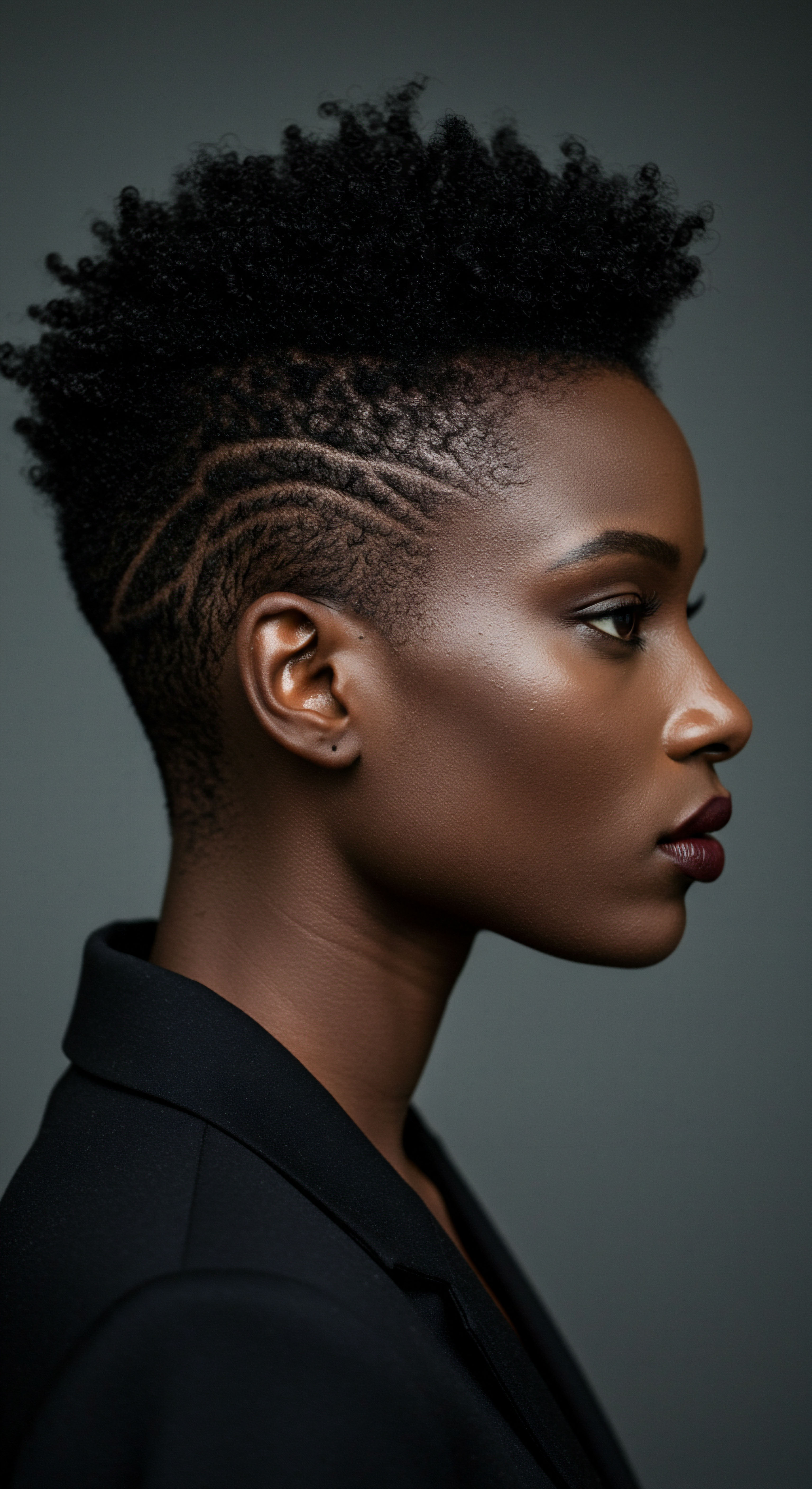
Roots
The ancient world, with its grand empires and quiet domestic scenes, often held beauty as a profound reflection of social standing and personal identity. For Roman women, particularly those of means, their hair was a living crown, meticulously sculpted into gravity-defying structures that spoke volumes without uttering a single word. These coiffures, sometimes towering, sometimes adorned with intricate braids and curls, were not mere fleeting trends; they were statements of wealth, status, and cultural adherence.
The time and skill invested in their creation, often by enslaved hairdressers known as ornatrices, signaled a lady’s position within society, her leisure, and her access to specialized labor. A woman’s hair, therefore, became a public display of her household’s prosperity.
The very act of styling these elaborate arrangements could consume hours. Literary accounts and archaeological findings paint a picture of mornings spent in diligent preparation, where bronze rods, heated in hot ashes, shaped curls, and countless hairpins of bone, bronze, or even precious metals held sections in place. The sheer scale of some of these styles, particularly during the Flavian and Trajanic eras, led writers like Juvenal to liken them to multi-story buildings, emphasizing their height and complexity.
Roman women’s elaborate hairstyles were living symbols of their social standing, demanding significant time and skilled labor for their creation.
Understanding the artistry of Roman hairstyles begins with appreciating their structure. These were not simple washes and go; they were architectural feats.

What Did Roman Hairstyles Look Like
Roman hairstyles evolved considerably over centuries, reflecting imperial tastes and societal shifts. Early Republican styles were often simpler, perhaps a bun at the nape or top of the head, secured with bands. As the Empire flourished, so too did the complexity of women’s hair.
The Flavian dynasty, for example, saw an explosion of high, curled styles, often achieved with wigs or hairpieces to add volume and height. These styles often featured:
- Tutulus ❉ An Etruscan style adopted by Roman materfamilias, where hair was piled high on the head, secured with a band.
- Nodus ❉ Popular during the Republican and Augustan periods, characterized by a distinct knot of hair above the forehead.
- Flavian Tower ❉ A towering arrangement of curls and braids, often supported by internal structures or false hair, becoming a hallmark of wealth and fashion.
These styles were not merely decorative; they were carefully constructed, often involving the use of hair extensions made from human or animal hair, or even fabric stiffened with beeswax, to create the desired volume and shape. The use of such materials highlights the resourcefulness and dedication to appearance prevalent among Roman women.

How Was Hair Important in Roman Society
Hair carried significant social and cultural weight in ancient Rome. Beyond mere aesthetics, a woman’s hairstyle conveyed her status, age, and even her moral character.
| Aspect of Hair Elaborate Styles |
| Societal Message High social standing, wealth, leisure, cultural sophistication |
| Aspect of Hair Simple Styles |
| Societal Message Associated with lower classes or, in some cases, a deliberate statement of traditional values (like Livia, wife of Augustus) |
| Aspect of Hair Loose Hair |
| Societal Message Often linked with "loose morals" for adult women, though common for young girls |
| Aspect of Hair Wigs and Dyes |
| Societal Message While popular for achieving fashionable looks, sometimes viewed with suspicion if used to conceal hair loss or age |
| Aspect of Hair Hair was a potent visual language in Roman society. |
The literary sources, though often written by men with their own biases, underscore the importance of hair. Ovid, for example, in his Ars Amatoria, offers advice on beauty routines, suggesting that women should keep their beauty secrets hidden from male gaze, implying the arduous nature of achieving these looks. The societal pressure to maintain a polished appearance was immense, and hair played a central role in this daily presentation.

Ritual
Stepping from the daylight splendor of Roman coiffures into the quiet of the night, one might wonder how such intricate creations survived the hours of slumber. The practical wisdom of Roman women, or more precisely, their ornatrices, was put to the test each evening. These styles, often built upon a foundation of braids, curls, and extensions, could not simply be left to their own devices.
To do so would mean a morning of painstaking re-creation, a luxury of time and labor not always available, even to the wealthy. The preservation of these hairstyles overnight was a ritual, a careful tending to the artistic statement that would greet the new day.
The challenge was multifaceted ❉ how to keep curls defined, braids tidy, and towering structures from collapsing into a tangled mess. The answer lay in a combination of specialized tools, protective coverings, and perhaps, a gentle application of conditioning agents.

What Did Roman Women Use to Protect Hair at Night?
Roman women employed a variety of methods and accessories to safeguard their elaborate hairstyles through the night. These solutions aimed to minimize disruption and maintain the integrity of the sculpted hair.
- Hairnets ❉ Archaeological findings, particularly from sites like Roman and Byzantine Egypt, reveal the use of hairnets, often made from finely woven linen or wool. These nets, sometimes crafted using a technique called “sprang” for elasticity, would have served to hold the hair in place, preventing tangling and flattening. Evidence suggests these were daily wear items, not just for burial.
- Head Coverings ❉ Beyond simple nets, some sources suggest the use of soft caps or scarves. These could provide an additional layer of protection against friction with pillows and the general movement during sleep. While specific “nightcaps” are not extensively detailed in classical texts, the general practice of covering the head was common for various reasons, including modesty and warmth.
- Hairpins ❉ The very tools used to construct the styles—bone, bronze, or ivory hairpins—would have remained in place to maintain the shape. These pins were essential for securing buns, braids, and looped curls. Their continued presence overnight would have provided structural support.
The application of certain substances might also have played a role. While modern hair products were absent, ancient Romans did use oils and balms for hair care. Olive oil, honey, and even eggs are mentioned as hair treatments. A light application of such an oil might have helped to keep hair supple and reduce friction, making it less prone to frizz or breakage overnight.
Roman women preserved their complex hairstyles overnight using hairnets, soft head coverings, and the very hairpins that sculpted their daytime looks.

How Did Wigs and Hairpieces Affect Nighttime Care?
Wigs and hairpieces were common in Roman society, especially for achieving the dramatic height and volume fashionable in certain periods. The presence of these additions introduced a different set of considerations for nighttime protection.
For styles incorporating significant false hair, whether full wigs or smaller extensions sewn into natural hair, the preservation strategy would have been even more critical. Wigs, being separate entities, could be removed and stored on stands or forms to retain their shape. This practice, while not explicitly detailed in ancient Roman texts for nighttime, is a logical extension of wig care across many historical periods and is akin to modern wig maintenance. For example, contemporary advice for wig care stresses storing them on a wig head to preserve style and prevent tangling, along with gentle cleansing and conditioning.
Hairpieces that were sewn or pinned into natural hair would have required more delicate handling. It is likely these were left in place for several days, given the effort involved in their application. Juvenal, the Roman satirist, alludes to the painstaking process of creating these towering styles, suggesting they might be left on for up to a week to avoid frequent repetition of the laborious process.
This implies that nighttime protection was not just about comfort, but about extending the life of the style. The structural elements, such as wires or stiffened fabric, would have been vital in preventing collapse.
Consider the case of the empress Messalina, wife of Claudius, and Empress Faustina, who reportedly owned hundreds of wigs. While this number speaks to their immense wealth and desire for varied appearances, it also points to a logistical challenge ❉ how to care for such a vast collection. Their ornatrices would have been skilled not only in styling but also in the preservation and maintenance of these valuable hairpieces.
| Method Hairnets (Reticula) |
| Purpose Contain and secure hair, prevent tangling |
| Evidence/Context Archaeological finds from Egypt, Pompeii frescoes |
| Method Soft Caps/Scarves |
| Purpose Additional physical barrier against friction and flattening |
| Evidence/Context Inferred from general head covering practices |
| Method Hairpins |
| Purpose Maintain structural integrity of curls and braids |
| Evidence/Context Numerous archaeological finds |
| Method Oils/Balms |
| Purpose Conditioning, reducing friction, promoting suppleness |
| Evidence/Context Ancient recipes mention olive oil, honey, eggs for hair |
| Method Wig Stands/Forms |
| Purpose Preserve wig shape when not worn |
| Evidence/Context Inferred from practical wig maintenance, though direct Roman evidence is scarce |
| Method Roman women utilized a combination of physical barriers and practical aids to preserve their elaborate hairstyles through the night. |

Relay
To truly comprehend the nocturnal practices of Roman women concerning their hair, one must look beyond the immediate mechanics and consider the broader currents of their world. How did societal expectations, the available knowledge of hair itself, and the very fabric of daily life shape these intimate rituals? The act of protecting a hairstyle overnight was not merely a chore; it was a silent conversation with social norms, a practical application of empirical observation, and a testament to the cultural value placed upon outward presentation. This intricate interplay reveals a deeper understanding of Roman womanhood.
The elaborate hairstyles, as we have seen, were declarations of status. The maintenance of these styles, extending into the quiet hours of sleep, underscores the relentless pressure to maintain this visual standard. A disheveled appearance in the morning would not simply be a personal inconvenience; it could subtly diminish one’s perceived standing.

How Did Hair Care Reflect Social Hierarchy?
The social stratification of Roman society was deeply reflected in hair care. Wealthy women commanded the time and labor of enslaved ornatrices who were skilled in creating and maintaining these complex coiffures. These hairdressers, often themselves with short hair to signify their enslaved status, were instrumental in upholding the beauty standards of their mistresses.
The time investment alone was a clear marker of status. While a woman of lower means might tie her hair simply, a patrician woman could spend hours in the morning being attended to. This was not considered a waste of time by society, but rather a necessary display of her family’s prosperity.
The very existence of specialized hairpins made from precious materials, or even featuring miniature portraits, speaks to the luxury associated with hair adornment. The more “unnatural” and complex the style, the greater the display of wealth, as it implied the means to afford its creation and upkeep.
The maintenance of elaborate Roman hairstyles, extending into the night, was a profound social act, reflecting status and wealth through dedicated labor and resources.

What Was the Early Understanding of Hair Health?
While the Romans lacked modern scientific understanding of hair biology, their practical observations and traditional remedies offer a glimpse into their approach to hair health. Ancient texts, such as those by Pliny the Elder and Ovid, contain numerous recipes for hair treatments, dyes, and remedies for hair loss. These concoctions, often made from natural ingredients, suggest an empirical understanding of what might nourish or strengthen hair, even if the underlying mechanisms were unknown.
For instance, Pliny the Elder discusses the use of animal fats, ashes, and various plant extracts for hair. He mentions soap, a Gaulish invention made from tallow and ashes, primarily as a pomade for hair, noting its use for reddening hair among Germanic tribes. While not a modern shampoo, this substance would have served a cleansing and perhaps conditioning purpose.
Ovid also mentions vegetable dyes and expresses concern over the damage caused by repeated dyeing and heated tongs. This suggests an awareness of hair fragility and the detrimental effects of certain practices.
A particularly intriguing example of ancient hair treatment, highlighting both the empirical approach and potentially controversial ingredients, comes from Roman texts describing remedies for hair loss. Pliny the Elder, in his Natural History, mentions the application of a sow’s gall bladder mixed with bull’s urine, or the ashes of an ass’s genitals, as cures for balding. More strikingly, some Roman recipes for gray hair involved a paste made from herbs and crushed earthworms, applied overnight.
This demonstrates a willingness to experiment with a wide array of natural (and sometimes unpleasant) substances in the pursuit of hair aesthetics and health, even if the efficacy was questionable by modern standards. Such practices, while seemingly strange to us, underscore the lengths to which individuals would go to maintain their appearance and the practical knowledge accumulated over generations.
The emphasis on protective coverings like hairnets also points to an intuitive understanding of physical damage. By securing the hair, they reduced friction, prevented tangling, and minimized the need for re-styling, which itself could cause breakage. This preventive approach, rooted in daily experience, aligns with modern hair care principles that stress gentle handling and protection to preserve hair integrity, particularly for textured strands prone to damage.
- Physical Protection ❉ Hairnets and scarves provided a barrier against friction and movement during sleep.
- Moisture Retention ❉ The application of oils or balms likely helped keep hair supple, reducing dryness and breakage.
- Structural Support ❉ Hairpins and internal frames helped maintain the elaborate shape, reducing the need for extensive re-styling.

Reflection
The quiet moments before sleep, when Roman women attended to their elaborate coiffures, whisper across centuries, carrying echoes of universal desires. These rituals, whether involving delicate hairnets or the careful placement of pins, speak to a timeless human inclination to preserve what is valued, to protect beauty, and to prepare for the demands of a new day. The ingenuity employed, from simple fabric to complex systems of support, reveals a profound connection between personal appearance and societal standing.
Even today, as we consider the unique needs of textured hair and the wisdom of protective styling, we find ourselves in a continuum with these ancient practices, seeking comfort, longevity for our styles, and the quiet assurance that our crowning glory will greet the morning with grace. The Roman experience reminds us that care, in its deepest sense, transcends eras, finding its expression in the intimate gestures we offer to ourselves, and to our hair, each night.

References
- Bartman, E. “Hair and the Artifice of Roman Female Adornment.” American Journal of Archaeology, Vol. 105, No. 1, 2001, pp. 1-25.
- Cool, Hilary E.M. “Roman Metal Hair Pins from Southern Britain.” Archaeological Journal, Vol. 147, 1990, pp. 148-182.
- Crummy, Nina. Colchester Archaeological Report 2 ❉ The Roman Small Finds from Excavations in Colchester 1971-9. Colchester Archaeological Trust, 1983.
- Henig, Martin. “Bone Hairpins.” Archaeologia Aeliana, Vol. 5, No. 5, 1977, pp. 359-361.
- Juvenal. Satires. Translated by G.G. Ramsay, Loeb Classical Library, Harvard University Press, 1918.
- Linscheid, Petra. “Hairnets and Bonnets in Late Roman and Byzantine Egypt.” Ancient Textiles, Ancient Techniques, Ancient Societies ❉ Proceedings of the First European Textile Forum. 2002.
- Ovid. Ars Amatoria. Translated by J.H. Mozley, Loeb Classical Library, Harvard University Press, 1929.
- Pliny the Elder. Natural History. Translated by H. Rackham, Loeb Classical Library, Harvard University Press, 1938-1962.
- Sheffer, Avigail, and Hero Granger-Taylor. Masada IV ❉ The Yigael Yadin Excavations 1963-1965, Final Reports. Israel Exploration Society, 1994.